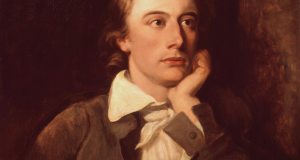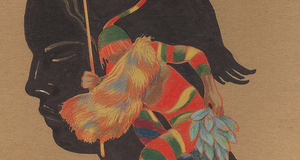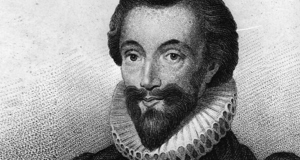Death in John Keats' "Ode to a Nightingale" and "The Eve of St. Agnes"
By
2021, Vol. 13 No. 02 | pg. 1/1 AbstractThis paper explores Keats’ depiction of death in “Ode to a Nightingale” and “The Eve of St. Agnes.” “Ode to a Nightingale” juxtaposes two types of death. The first kind of death is a drowsy union with nature which allows the speaker to merge with the world around him. The speaker embraces this metaphorical death because he is terrified of literal death and its ugliness. Literal death is not a unifying force, but an isolating reality that wrecks the speaker’s unity with the nightingale and imprisons him in his “sole self.” While readers may initially assume that “The Eve of St. Agnes” is simply a happy romance, it contains a depiction of death similar to that of “Ode to a Nightingale.” In this poem, Madeline experiences unifying death when losing touch with reality enables her to consummate her relationship with Porphyro. But while Madeline’s figurate death is unitive, the Beadsman lives (and eventually dies) in the isolating sphere of failed transcendence. Keats’ “Ode to a Nightingale” and “The Eve of St. Agnes” portray two opposing kinds of death: a figurative death that is a step towards union, and a death that is an isolating force. Although the poems were written within a few months of each other, Keats’ “Ode to a Nightingale” and “The Eve of St. Agnes” initially appear to have entirely different themes: the former work describes the speaker’s sad loss of transcendence, while the latter is a love story that ends in happy union (Bate 437, 501). However, a closer examination of the works shows that they share a similar portrayal of death. In “Ode to a Nightingale,” the speaker yearns for death that will lead him to union with beauty, and enters a death-like state that brings him into fellowship with the world; however, the transcendence he longs for is ultimately destroyed by the recognition of literal mortality. In a similar way, the Beadsman in “The Eve of St. Agnes” attempts to unite himself to heaven, but fails to gain transcendence and dies instead. However, in this poem Madeline is able to gain union with her lover by enduring the loss of her senses; she passes through an experience similar to that of the “Ode to a Nightingale” speaker, but succeeds in avoiding death’s isolation. Keats’ poems “Ode to a Nightingale” and “The Eve of St. Agnes” portray two opposing kinds of death: a figurative death that is a step towards union, and a death that is an isolating force. “Ode to a Nightingale” opens with the speaker’s desire for death: in this positive portrayal of death, the speaker enters a state of detachment from the world that results in union with the nightingale. The speaker feels as if he has been drugged, and becomes disconnected from the world by sinking towards a death-like forgetfulness: “One minute past, and Lethe-wards had sunk” (2). By alluding to the underworld river Lethe, the speaker shows that he wishes to move away from the human world; while death will enter the poem more explicitly in the coming stanzas, even in these first few lines the poet begins to hint at the theme (Evert 260; Bush 135). This first allusion to death is purely positive–the speaker falls into a figurative death because of happy union with the nightingale. Death is the product of joy, not sorrow: “’Tis not through envy of thy happy lot, / But being too happy in thine happiness” (5-6). The speaker’s descent into the forgetfulness of death allows him to enter into the nightingale’s joy; by cutting his ties to the world, he becomes united to the beauty of the bird’s song.In stanza five, the speaker enters into a death-like state of darkness and experiences the world without sight: this figurative death leads to a deeper unity with the beauty of the world around him. The speaker sits in darkness and senses the objects in the garden without seeing them: “I cannot see what flowers are at my feet, / Not what soft incense hangs upon the boughs, / But, in embalmed darkness, guess each sweet” (41-43). The world “embalmed” can denote both pleasant smells and the preserving of a dead body; this dual meaning introduces the theme of death into the description of the dark garden (“embalmed,” adj., “embalm, v.”). Andrew Kappel notes that all senses except sight are present in the speaker’s experience of the garden: he tastes “each sweet” and the “dewy wine,” hears the sound of flies, smells the “embalmed darkness” and “musk-rose” and touches violets hidden beneath the leaves (274-275). Kappel goes on to argue that because the speaker looses his sight, he is able to see the world around him through the imagination alone: this experience gives him an intimate sensory experience with the garden (275). By entering into a state of death-like blindness, the speaker attains a deep union with his surroundings; sight becomes unnecessary, as his other senses form a closer connection between him and the beautiful beings in the garden. But although the speaker wishes to die and be united with beauty, he shuns the ugliness of the physical death around him: while Keats uses the same word to denote the speaker’s transcendent state and the death of isolation, the two uses have entirely different meanings. In the third stanza, the speaker reveals that his wish to dissolve is motivated by a desire to avoid the world’s suffering and death; he wishes to forget the world “Where palsy shakes a few, sad, last gray hairs, / Where youth grows pale, and spectre-thin, and dies” (25-26). In such a world, true beauty and love cannot exist: “Where Beauty cannot keep her lustrous eyes, / Or new Love pine at them beyond to-morrow” (29-30). The speaker desires to move beyond the mutability of the world because these changes make beauty and love fleeting: in the presence of death, no eternal union is possible (Bush 115). At the end of the poem, the speaker’s attempt at a unifying death through the imagination is ruined when he recognizes his literal mortality: “Forlorn! the very word is like a bell / To toll me back from thee to my sole self!” (71-72). Mortality pulls the speaker back from his vision of the nightingale’s immortality–the deathbell of reality tears him from unity with the nightingale, and imprisons him within his “sole self” (72). The death expressed in stanza three and the end of the poem is directly opposed to the death-like slipping towards unity that the speaker desires: unifying death reduces the self in order to bring humans into fellowship with their surroundings, while destructive death kills through isolation. In “The Eve of St. Agnes,” Keats portrays isolating death through the character of the Beadsman: while this holy man seeks union with God throughs prayer, he is unable to attain it and eventually dies alone. The poem opens with a description of the Beadsman praying in the freezing cold, and describes his breath “taking flight for heaven, without a death” (8). This description seems positive: the holy man is able to send his prayers to God without dying, attaining unity with the immutable without the sacrifices that even unifying death necessitates. However, the following lines show that the Beadsman is association with an deathly isolation: he is surrounded by the statues of the dead that line the chapel aisle (13-14). The statues too, even in their deathly state, are engaged in prayer: “The sculptur’d dead, on each side, seem to freeze, / Emprison’d in black, purgatorial rails: / Knights, ladies, praying in dumb orat’ries” (14-16). Like the Beadsman, the sculptures attempt to unite themselves with heaven. But instead of reaching beyond themselves, they are only trapped by their devotion: they “ache in icy hoods and mails” (18). The cold temperature associates the figures with death: both they and the Beadsman exist in a dead, frozen world (Blackstone 275). The statues are also “Emprison’d in black, purgatorial rails”; this language suggests that the figures are in a place of pain rather than beauty (15). The portrayal of the Beadsman as a “meagre, barefoot, wan” man connects him to the description of negative death in “Ode to a Nightingale” (12). The Beadsman and his chapel are associated with isolating death; its seems that the Beadsman’s prayers take “flight for heaven, without a death” because he fails to attain the unifying death that could connect him to beauty (8). Without good death, he and his chapel are frozen in a failed transcendence that results only in isolation. Like the speaker of “Ode to a Nightingale,” the Beadsman has a strong reaction to music and could participate in its joy; however, he is unable to fully enter into the song because his is marked by death. Although he is “Flatter’d to tears” by “Music’s golden tongue,” the holy man is pulled from the music by his association with death: “But no–already had his deathbell rung; / The joys of all his life were said and sung” (21, 20, 23-24) Just as the recognition of mortality tears the “Ode to a Nightingale” speaker from his vision, the Beadsman’s connection with death will not allow him to unite with the song he hears. The Beadsman is already dead to the world: while he remains physically alive, he is incapable of participating in the joy of the world around him. His death-in-life turns to literal death at the end of the poem, where he dies forgotten by the world: “The Beadsman, after thousand aves told, / For aye unsought for slept among his ashes cold” (377-378). Keats presents unifying death through the character of Madeline: while she figuratively dies, her death unites her to Porphyro. Madeline must be silent during her attempt to complete the ritual of St. Agnes, and Keats compares her silence to a dying bird: “As though a tongueless nightingale should swell / Her throat in vain, and die, heart-stifled, in her dell” (206-207). Madeline’s efforts to unite with her future husband result in the death of her voice. In a similar way, her sleep is deathlike: her soul is “fatigued away,” and she is “blinded alike from sunshine and from rain” (238, 242). But just as the speaker’s blindness in “Ode to a Nightingale” leads him to a fuller union with the world around him, Madeline’s death-like loss of her senses allows her to unite with Porphyro. Madeline and Porphyro are only able to consummate their love because Madeline is in a half-dreaming state; Porphyro is “melted” into the dream, and Madeline’s shock at reality shows that she only slept with him because she believed that he was a vision (320, 328). But while the couple’s love is the result of figurative death, it leads to the union of the couple; Madeline says that her “heart is lost in [Porphyro’s],” showing that the two are united on an emotional as well as a sexual level. The Beadsman’s death isolates him; Madeline’s figurative death unites. Keats further demonstrates the difference between the two types of death with a radical change in temperature: while the Beadsman’s dead setting is freezing cold, the world of the lovers is filled with warm images such as Madeline’s “balmy side” and the “poppied warmth” of her sleep (205, 237; Blackstone 275). While the same imagery of death describes both the Beadsman and the couple’s experience, the holy man endures an isolating death that is the enemy of Madeline’s uniting death. Madeline and Porphyro’s escape is also marked by figurative death; this unifying death stands in sharp contrast to the isolating death around them. Jacqueline Banerjee notes that the lovers’ escape is a kind of transcendence over the death that permeates their surroundings: Madeline and Porphyro avoid the ugly death that the Beadsman and Angela fall into at the end of the poem (533). However, Keats compares the lovers to ghosts as they escape together: “They glide, like phantoms, into the wide hall; / Like phantoms, to the iron porch, they glide” (361-362). In order to attain freedom and unity, the couple must enter into a death-like state of silence similar to the death of Madeline’s senses. But like the dying nightingale simile, this kind of death has a positive result: the couple are able to escape the literal death that Madeline’s family threatens Porphyro with, and assumably proceed to the union of the home that Porphyro has for Madeline (351). “Ode to a Nightingale” and “The Eve of St. Agnes” move in opposite directions. The “Ode to a Nightingale” speaker begins in a death-like state that brings him happy union with the nightingale–but in the end, he is ripped from his vision by the harsh reality of isolating death. But while “The Eve of St. Agnes” begins with the Beadsman’s isolation through death, Madeline successfully unites with Porphyro by experiencing a death-like loss of her senses. Both “Ode to a Nightingale” and “The Eve of St. Agnes” hold unifying and isolating death in tension; the poems differ not in their portrayal of the two kinds of death, but in the type of death that triumphs at the end of each poem. For Keats, death is inescapable–the question is not whether his characters will die, but which death they will endure. ReferencesBanerjee, Jacqueline. “Mending the Butterfly: The New Historicism and Keats’s ‘Eve of St. Agnes.’” College English, vol. 57, no. 5, 1995, pp. 529–546. Bate, Walter Jackson. John Keats. Oxford UP, 1967. Blackstone, Bernard. The Consecrated Urn: an Interpretation of Keats in Terms of Growth and Form. Greenwood Press, 1978. Bush, Douglas. John Keats: His Life and Writings. Macmillan, 1966. Evert, Walter H. Aesthetic and Myth in the Poetry of Keats. Princeton UP, 1965. Kappel, Andrew J. “The Immortality of the Natural: Keats’ ‘Ode to a Nightingale.’” English Literary History, vol. 45, no. 2, Summer, 1978, pp. 270-284. Keats, John. Completed Poems. Edited by Jack Stillinger, Belknap, 1982. – – –. “The Eve of St. Agnes.” The Norton Anthology of English Literature, edited by Stephen Greenblatt, 9th ed., Vol. D, W.W. Norton, 2012, pp. 912-922. – – – . “Ode to a Nightingale.” The Norton Anthology of English Literature, edited by Stephen Greenblatt, 9th ed., Vol. D, W.W. Norton, 2012, pp. 927-929. – – –. Selected Letters of John Keats. Edited by Grant F. Scott, Harvard UP, 2005. Suggested Reading from Inquiries Journal
Inquiries Journal provides undergraduate and graduate students around the world a platform for the wide dissemination of academic work over a range of core disciplines. Representing the work of students from hundreds of institutions around the globe, Inquiries Journal's large database of academic articles is completely free. Learn more | Blog | Submit Latest in Literature |
















